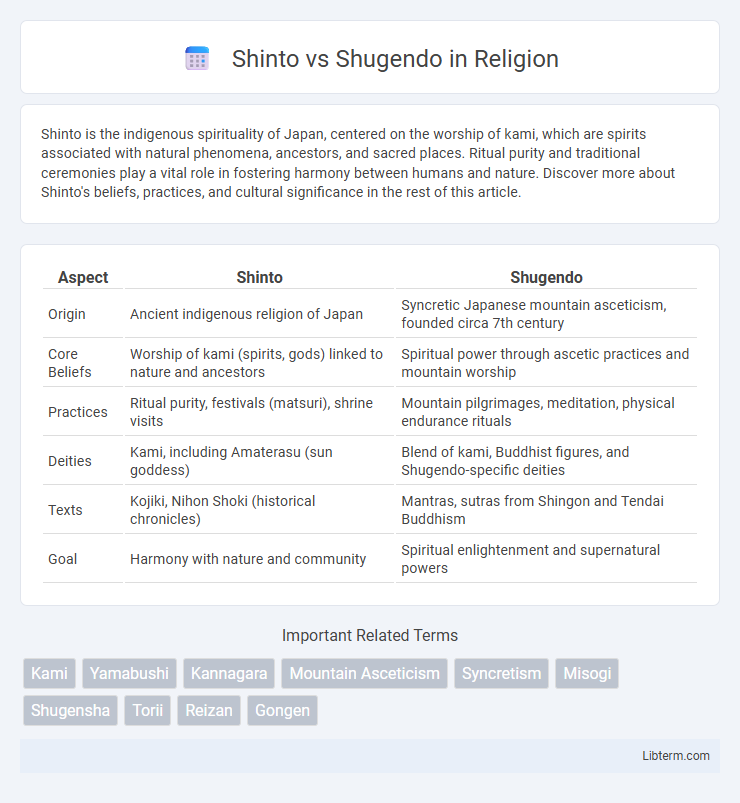Shinto is the indigenous spirituality of Japan, centered on the worship of kami, which are spirits associated with natural phenomena, ancestors, and sacred places. Ritual purity and traditional ceremonies play a vital role in fostering harmony between humans and nature. Discover more about Shinto's beliefs, practices, and cultural significance in the rest of this article.
Table of Comparison
| Aspect | Shinto | Shugendo |
|---|---|---|
| Origin | Ancient indigenous religion of Japan | Syncretic Japanese mountain asceticism, founded circa 7th century |
| Core Beliefs | Worship of kami (spirits, gods) linked to nature and ancestors | Spiritual power through ascetic practices and mountain worship |
| Practices | Ritual purity, festivals (matsuri), shrine visits | Mountain pilgrimages, meditation, physical endurance rituals |
| Deities | Kami, including Amaterasu (sun goddess) | Blend of kami, Buddhist figures, and Shugendo-specific deities |
| Texts | Kojiki, Nihon Shoki (historical chronicles) | Mantras, sutras from Shingon and Tendai Buddhism |
| Goal | Harmony with nature and community | Spiritual enlightenment and supernatural powers |
Introduction to Shinto and Shugendo
Shinto is the indigenous spirituality of Japan centered on kami, sacred spirits representing natural elements and ancestors, emphasizing rituals, purity, and harmony with nature. Shugendo is a syncretic Japanese mountain ascetic practice combining elements of Shinto, Buddhism, and Taoism, focused on spiritual power through rigorous physical endurance and meditation in sacred mountains. Both traditions emphasize connection to nature but differ in practice scope, with Shinto rooted in ritual worship and Shugendo in ascetic training.
Historical Origins of Shinto
Shinto, Japan's indigenous spirituality, traces its origins to ancient animistic practices and rituals venerating kami, or sacred spirits, deeply rooted in the Yamato period around the 3rd century CE. Shugendo, emerging later during the Heian period (794-1185), synthesizes Shinto beliefs with esoteric Buddhism and Taoism, emphasizing mountain asceticism and spiritual discipline. The historical development of Shinto's kami worship forms the foundational religious context from which Shugendo evolved as a unique syncretic tradition.
Historical Development of Shugendo
Shugendo developed during the Heian period in Japan as a syncretic spiritual tradition, blending elements of Shinto, esoteric Buddhism, and Taoism to cultivate mountain asceticism and supernatural powers. Rooted in the worship of mountain deities and rigorous physical discipline, Shugendo practitioners, known as yamabushi, aimed to achieve spiritual enlightenment and healing through pilgrimage and ascetic practices. The tradition reflects Japan's historical integration of indigenous Shinto beliefs with imported Buddhist practices, evolving as a distinct path emphasizing harmony with nature and spiritual empowerment.
Core Beliefs and Worldviews
Shinto centers on the worship of kami, spirits embodying natural elements and ancestral forces, emphasizing purity, rituals, and harmonious living within the natural world. Shugendo integrates Shinto animism with esoteric Buddhism and Taoism, focusing on ascetic practices, mountain worship, and spiritual empowerment through rigorous physical and spiritual training. Both traditions view nature as sacred but differ as Shinto maintains a celebratory relationship with kami, while Shugendo emphasizes transformative spiritual discipline to attain enlightenment and supernatural abilities.
Key Deities and Spiritual Figures
Shinto centers on kami such as Amaterasu, the sun goddess, and Susanoo, the storm god, who embody natural forces and ancestral spirits. Shugendo integrates Buddhist figures like Fudo Myo-o, the immovable protector, with Shinto kami, creating a syncretic practice emphasizing mountain asceticism. Both traditions honor nature and spiritual power, but Shinto focuses on native deities, while Shugendo blends esoteric Buddhism with indigenous beliefs.
Ritual Practices and Ceremonies
Shinto rituals center on purification rites, offerings to kami (spirits), and seasonal festivals such as Matsuri, emphasizing harmony with nature and ancestral worship. Shugendo integrates esoteric Buddhist practices with Shinto elements, featuring ascetic mountain pilgrimages, fire-walking ceremonies, and meditation aimed at spiritual empowerment and enlightenment. Both traditions utilize symbolic objects like sacred ropes (shimenawa) and ritual implements, but Shugendo's ceremonies often involve rigorous physical endurance to attain supernatural powers.
Sacred Sites and Pilgrimage Traditions
Shinto sacred sites prominently include grand shrines like Ise Jingu and Izumo Taisha, revered for their connection to kami deities and nature worship, while pilgrimage traditions often involve visiting these shrines during festivals such as the Ise Grand Shrine pilgrimage. Shugendo, a syncretic practice blending Shinto, Buddhism, and Taoism, emphasizes mountain asceticism with sacred sites like Mount Haguro and Mount Kumano, where practitioners undertake rigorous pilgrimages known as Shugendo shugyo to achieve spiritual empowerment through physical endurance. Both traditions value natural landscapes as spiritual realms, but Shinto centers on ritual purity and deity veneration, whereas Shugendo focuses on transformative mountain training and mystical experiences.
Influence on Japanese Culture and Society
Shinto, as Japan's indigenous spirituality, deeply influences Japanese culture through rituals, festivals, and the veneration of kami, shaping social customs and community cohesion. Shugendo, a syncretic tradition blending Shinto, Buddhism, and Taoism, impacts Japanese society by promoting ascetic practices and mountain worship, emphasizing spiritual discipline and harmony with nature. Both traditions contribute to Japan's cultural identity by maintaining a connection to nature and fostering communal values.
Differences in Contemporary Practice
Shinto primarily revolves around the worship of kami through rituals at shrines, emphasizing purity, festivals, and seasonal observances, while Shugendo integrates esoteric Buddhism, ascetic mountain practices, and spiritual discipline performed by yamabushi practitioners. Contemporary Shinto practices are community-centered and involve ceremonies for life events and agricultural cycles, whereas Shugendo focuses on rigorous solitary or group mountain pilgrimages seeking supernatural powers and enlightenment. The distinction lies in Shinto's open, ritualistic connection to nature deities compared to Shugendo's syncretic, meditative, and physically demanding spiritual training in mountainous environments.
Shinto and Shugendo: Convergence and Divergence
Shinto and Shugendo share a deep connection through their reverence for nature and spiritual practices rooted in Japan's indigenous beliefs, emphasizing purification and mountain worship. Shinto centers on kami worship and ritual purity in shrines, while Shugendo blends Shinto with esoteric Buddhism, focusing on ascetic mountain training for spiritual enlightenment. Their divergence lies in Shugendo's syncretic, rigorous physical practices and Buddhist influence, contrasting with Shinto's primarily ritualistic, community-based worship.
Shinto Infographic

 libterm.com
libterm.com